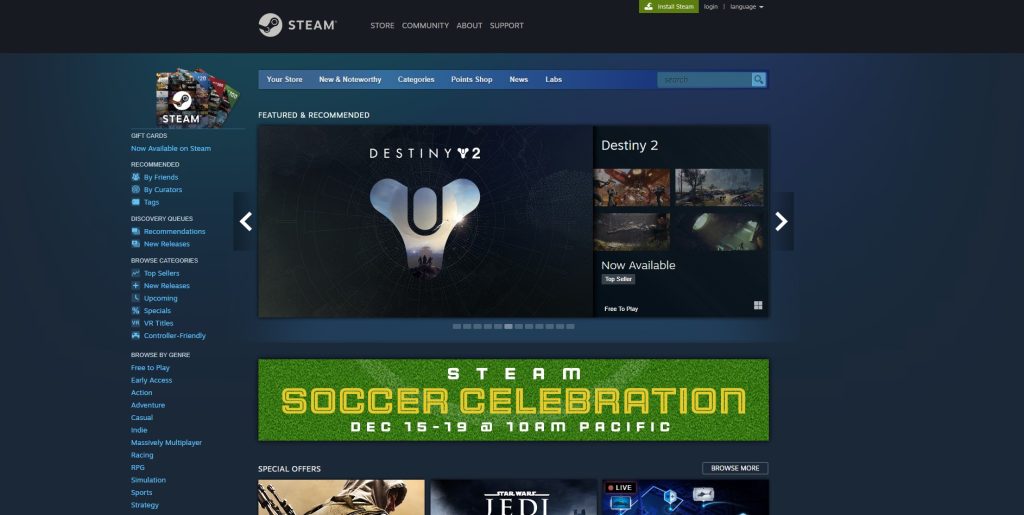Steam is a platform created by the company Valve where game developers can sell their games to gamers who want to buy them. According to the article “The 19-Year Evolution of Steam” by Matt Sayer and Tyler Wilde it came out all the way back in September of 2003 (Fig 1), so it has been around for quite some time now, and during that time it has gone through multiple variations. When it first came out it was simply a tool for Valve to be able to release automatic updates for their own games but in 2005 Valve expanded the platform to allow other publishers’ titles. The company behind Steam, Valve, is a business so it must find some way to make money from the platform. They take a 30% cut of each game sold and the developer gets the other 70%. Many customers will go to Steam to buy games they saw in other places, but many people will also look through Steam’s recommendations to find new games. Steam’s recommendation algorithm is a big part of what it is because without it the platform would not be able to recommend games that customers would want to play, and they would stop using the platform.
Over the years Steam has grown exponentially to where today the platform has tens of millions of users and over fifty-thousand games on the platform. With those fifty-thousand games there comes a need for an algorithm to recommend those games to customers. Once again referring to the article by Matt Sayer and Tyler Wilde we can see that Steam didn’t introduce a recommendation system until 2011 as the platform had grown to a point where there were starting to be too many games, around 3,000, for users to effectively search through. This was introduced in the form of a recommended tab on the main menu. 2014 was the big shift to what we know today. The main store page upon login is plastered with personalized recommendations as well as a discovery queue for users to be able to go through and find new games (Fig 2). Today the platform works on many factors, but according to Joel Hruska, the biggest factors are that “it looks at what games you play and what games other people play, then makes informed suggestions based on the decisions of other people playing games on Steam,” (Hruska). Based on that knowledge of how the algorithm works as well as direct statements from Valve in the article by Joel Hruska we know that the platform does indeed use a type of machine learning algorithm called a neural network that was trained using the data of millions of Steam users. A neural network is a kind of algorithm that uses data that it had been fed in order to make predictions about future situations (Wikipedia). For example, what kind of game a steam customer may enjoy and want to purchase. The network takes the data you have given it through what you have played, cross references that data with data from other players, and gives you recommendations based on those results.


The unintended consequence of this system of recommending games that other players are playing is that it creates a system that can be very momentum based. An indie game can sit in obscurity for years but then one big streamer or YouTuber will discover it and it will completely blow up and go headlong into the mainstream. However, this can mean that your games can permanently stay in obscurity if it is never discovered like that. AAA games have found a way around that and in a way game the system. AAA games are games made by popular and well-known studios and published by big-name publishers like Electronic Arts, Activision, Gearbox, etc., that can afford to spend thousands upon thousands of dollars on marketing to make sure that their games skip past the discovery phase and go straight into the mainstream.
Works Cited
Hruska, Joel. “Valve Introduces Machine Learning Algorithm to Recommend New Steam Games.” ExtremeTech, ExtremeTech, 12 July 2019, https://www.extremetech.com/gaming/294859-valve-introduces-machine-learning-algorithm-to-recommend-new-steam-games#:~:text=It%20disregards%20most%20of%20the,people%20playing%20games%20on%20Steam. Accessed 12 Dec. 2022.
Sayer, Matt, and Tyler Wilde. “The 19-Year Evolution of Steam.” Pcgamer, PC Gamer, 12 Sept. 2022, https://www.pcgamer.com/steam-versions/. Accessed 12 Dec. 2022.
Wikipedia. “Neural Network.” Wikipedia, Wikimedia Foundation, https://en.wikipedia.org/wiki/Neural_network. Accessed 18 Dec. 2022.